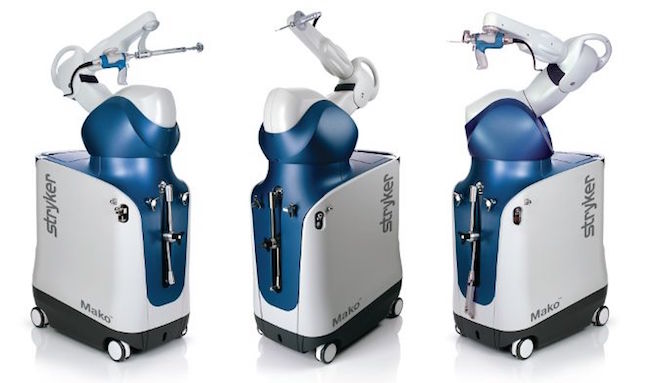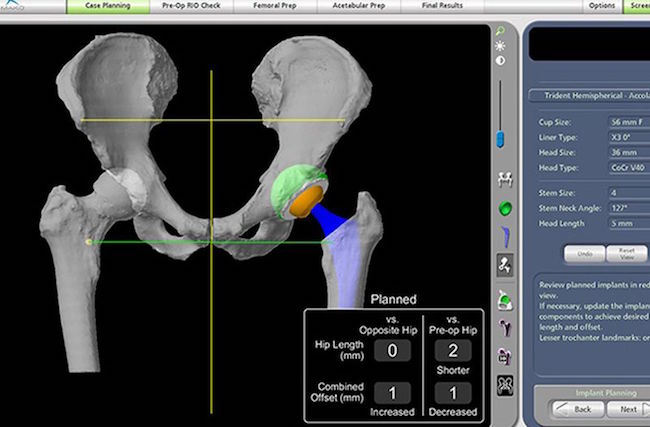First Mako Rio surgery robot comes to Hamilton, Ontario
Article/Photos: Design Engineering | Reporter: Devin Jones | December 4th, 2018

Hamilton, Ontario, has recently acquired Canada’s first robot cleared to perform knee and eventually hip replacements at St. Joseph’s Healthcare. St. Joseph’s is an academic and research-based medical affiliate of the St. Joseph’s Health System (SJHS), associated with McMaster University and Mohawk College.
Representing the first step towards St Joseph’s goal of opening an Orthopaedic Robotic Surgery Centre, the Mako Rio Surgical Robotic System utilizes 3D imaging technology and miniaturized surgical instruments placed throughout the area of operation. Rio generates a 3D model of the surgery based on the results of a previous CT scan, and as surgeons use the robotic arm to resurface the knee for placement of the implants, Rio will provide real-time inter-operative visual, tactile and auditory feedback. This enables a high level of precision and optimal positioning of the implants during surgery.
“I’ve known about the technology for about two years now,” said Dr. Anthony Adili, an orthopedic surgeon and chief of surgery at St. Joseph’s Healthcare Hamilton. “We wanted to do our due diligence and understand the role of this technology in our centre before we decided to implement it.”
According to Dr. Adili, money for Rio was raised over the period of a year and a half and was delivered in late October. The first procedures will be performed in January 2019. Until that time, Rio will be used for research purposes, gathering information for an evidence-based approach on how to use the system accurately. Dr. Adili spent time in the United States learning and training on the Rio. Come January he’ll have a surgeon from the U.S on hand, whose prior experience with the device will provide a valuable knowledge base for the first few surgeries.
“The real benefit is the accuracy of this machine. Now we can plan the entire surgery before we make a cut,” says Dr. Andili. “It allows us to take a step back and think of different ways to approach the surgery. For example, instead of cutting away part of the bone to match the implant, we can match the implant to the patient’s physical structure. It completely flips the surgery on its head.”

Mako Rio
Founded in 2004, Mako Surgical Corp. was acquired by Stryker in 2013 for $1.65 billion. As a Fortune 500 medical technologies firm based out of Michigan, Stryker is known for their medical implants used in joint replacements and trauma surgeries.
According to Stryker’s clinical evidence summary—available on their website—the surgical aspect of Rio is comprised of three primary steps: “Enhanced planning, dynamic joint balancing, and robotic-arm assisted bone preparation.” Currently, the Rio works within partial and total knee arthroplasty (reconstruction or replacement) and Total Hip Arthroplasty (THA).
The Mako system is designed to minimize the margin of error associated with component placement and to enhance the accuracy and reproducibility of the aforementioned surgeries. According to a paper cited within the literature, titled Improved accuracy of component positioning with robotic-assisted unicompartmental knee arthroplasty: data from a prospective, randomized controlled study, The Mako system showed a marked improvement in the placement of implant components versus a traditional manual method.
Additionally, when it comes to hip arthroplasty’s robotic-arm assisted THAs were five times more accurate in cup inclination (orientation of the socket to the coronal plane) and 3.4 times more accurate in cup anteversion (a specific technique used in hip replacements).
Prior to acquiring Rio, St. Joseph’s Healthcare was known for its centre of excellence in robotics. Since 2012, St. Joseph’s has worked with the Da Vinci robot which assists in head/neck and kidney surgeries. Performing invasive surgical procedures through tiny incisions, the device’s arm has a wrist that fully rotates 360 degrees, minimizing tissue damage and cutting down on surgery time. Since March 2012, well over 200 robotic surgeries have been performed.




